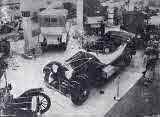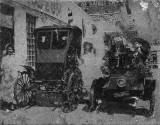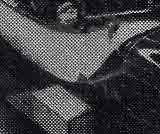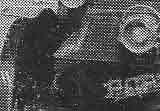Engraving Photo-Mechanical Processes |
||||
|
Here are two examples of a photo-mechanical engraving process as used in the early 20th century. Many thanks to Tom Laronga of Bellingham, Massachusetts, USA, for sending me several plates, including the two illustrated here. These plates would have been used for the rotary gravure process: i.e. attached to a large drum that rotated and was inked to produce images. This enabled many copies of the photos to be made quickly and cheaply, either as individual pictures or, perhaps for a magazine. The image is reversed, so lettering in the plate appears backwards. However, I have reversed the image to show the lettering right way round in the pictures above. Small dots can be seen on the plates. Looking at them under a magnifying glass, and in the enlargements of the details below, they can be seen to be very small holes like pin-pricks, of different sizes, that would retain ink to be transferred onto the printed image. In the darker areas of the plates the dots are smaller and, in some cases, futher apart. |
|
Engravers and Engraving |
||
A selection of Engravings |
||



